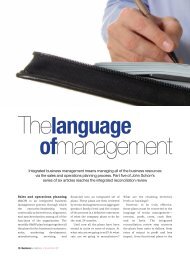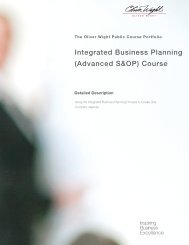Oliver Wight Caterpillar NACD Case - Oliver Wight Americas
Oliver Wight Caterpillar NACD Case - Oliver Wight Americas
Oliver Wight Caterpillar NACD Case - Oliver Wight Americas
Create successful ePaper yourself
Turn your PDF publications into a flip-book with our unique Google optimized e-Paper software.
OLIVER WIGHT CASE STUDY SERIES<br />
S&OP Gives <strong>Caterpillar</strong> a<br />
Competitive <strong>Oliver</strong> <strong>Wight</strong>Edge<br />
Courses & Workshops<br />
“ S&OP helps you get a good, accurate forecast number.<br />
The framework allows you to respond very quickly,<br />
January - December 2003<br />
which is pretty important from our standpoint. A quick<br />
response avoids or minimizes disruptions… and can yield<br />
more sales”<br />
Dale Roberts<br />
Manager, Sales & Operations Planning<br />
<strong>Caterpillar</strong> North American Commercial Division<br />
®<br />
together we make a difference
<strong>Caterpillar</strong> North American Commercial<br />
Highlights:<br />
• <strong>Caterpillar</strong>’s North American Commercial Division markets products<br />
from many plants and manages the company’s North American<br />
dealer network.<br />
• The division needed to coordinate its efforts more effectively with the<br />
manufacturing units on one side and independent dealers on the other.<br />
• Monthly Sales & Operations Planning meetings were introduced to<br />
help align team members on a commercial strategy and agree upon<br />
sales numbers.<br />
• Education and practice have enabled <strong>Caterpillar</strong> to achieve Class A,<br />
and 6 Sigma has begun to bring continuous improvement.<br />
• Confidence in <strong>NACD</strong>’s numbers enabled dealers to reduce inventory,<br />
while stabilizing product availability and reducing overall costs.<br />
As an industry leader, <strong>Caterpillar</strong> and its retail distribution network are continually<br />
under increasing competitive and cost pressures. Almost all its retail sales in<br />
North America are made through independent dealers. Since CAT covered 75%<br />
of the carrying cost of inventory, those dealers tended to overstock - carrying 3.5<br />
to 4 months of sales in inventory. This was expensive for CAT, and it exacerbated<br />
occasional inventory bubbles at CAT itself. The challenge was how to reduce<br />
unproductive cost, improve efficiency and not compromise customer service.<br />
With over $20 billion in sales and revenues, Fortune 100 company <strong>Caterpillar</strong><br />
manufactures its lines of construction and mining equipment in 48 plants in<br />
the U.S. and another 58 plants in 20 different countries. Its North American<br />
Commercial Division is responsible for distributing CAT products in markets<br />
that account for fully half of total sales. <strong>Caterpillar</strong> manages its decentralized<br />
and independent network of 63 U.S. and Canadian dealers and hundreds of<br />
locations with a single marketing organization: the North American Commercial<br />
Division. In effect, <strong>NACD</strong> is a wholesaler positioned between many of CAT’s<br />
factories and its retailers. However, the structure that CAT put in place inevitably<br />
made its internal communications and coordination more difficult than if each<br />
product line had an integral marketing team. <strong>NACD</strong> was the right structure<br />
in light of the established distribution network. But, it now needed to respond<br />
to competitive pressures - and to an important cost-control challenge.<br />
Approximately 10 years ago, <strong>Caterpillar</strong> reorganized the company into parallel<br />
business units: responsible for manufacturing, marketing and common business<br />
services. <strong>NACD</strong> discovered that this split made coordination with manufacturing<br />
more of a challenge.<br />
“When you break into a decentralized organization, people can get into silos,”<br />
said <strong>NACD</strong> S&OP Manager Dale Roberts, “They can easily forget about the<br />
overall company interests and concentrate on their own. So the issue becomes<br />
one of trying to balance those individual interests, which are constructive in<br />
many ways, and still keep everyone focused on the needs of the total company.”<br />
While this decentralized structure had worked well, there were pressing<br />
reasons to search for further improvement. Specifically, the group wanted to
“ S&OP has been ‘Win-Win-Win’<br />
for <strong>NACD</strong>, manufacturing, and<br />
our dealers,...”<br />
ensure that manufacturing and marketing had common strategies and that<br />
any action the two groups took was the result of a consensus they had arrived<br />
at jointly. Doing so would, the group hoped, improve efficiencies, response<br />
time, and, ultimately, financial returns. <strong>NACD</strong> needed to get better sales<br />
projections from dealers, while persuading those dealers that they could hold<br />
lower inventories of CAT products.<br />
At this point in time, <strong>Caterpillar</strong> CEO Glen Barton challenged each CAT division<br />
to perfect its key processes by seeking Class A certification. <strong>NACD</strong> responded<br />
by bringing in <strong>Oliver</strong> <strong>Wight</strong> consultants to assist in the project. John Pfeffer,<br />
then Vice President of <strong>NACD</strong>, concluded early on that Sales & Operations<br />
Planning could be the key to improvement. <strong>NACD</strong> and <strong>Oliver</strong> <strong>Wight</strong> quickly<br />
began to create an S&OP process and infrastructure. This, of course, required<br />
the closest coordination with both manufacturing and the dealer network.<br />
“The goal here was to set a valid production plan each month,” said <strong>Oliver</strong><br />
<strong>Wight</strong> consultant Pete Skurla. “<strong>NACD</strong>, as the major marketing organization,<br />
took mutual responsibility as the co-owner of any such effort. Such a joint<br />
effort would help the plants manage any risk associated with a new strategy.”<br />
The problem was that CAT’s marketing organization and the manufacturing<br />
groups often had been working with two sets of numbers, while each dealer<br />
tended to operate on their own.<br />
“A lot of times the marketing company might have a number that they would<br />
go with while the plant would have a different point of view,” Roberts said.<br />
“One group didn’t always believe the other’s numbers.”<br />
Sales projections and production plans had been formally reviewed quarterly<br />
and that was proving not frequent enough to handle a volatile market and<br />
inevitable changes in retail demand.<br />
S&OP Acts as Umbrella over Business Planning<br />
While many view Sales & Operations Planning as only a means to gain control<br />
and coordination of the operational elements of a business, it also acts as a<br />
good way to capitalize on opportunities by using the monthly planning sessions.<br />
“If forecasts change, the framework allows company groups to respond<br />
appropriately,” Roberts said. “It also helps assure that the right product is<br />
available to make the sale, while keeping inventories to a minimum. S&OP<br />
becomes a decision-making tool to keep the company on track with its growth<br />
and other critical success factors.”<br />
Regular, monthly meetings provided the key to <strong>NACD</strong>’s improvements. Using<br />
this vehicle enabled management to make better decisions with the knowledge<br />
that they would be implemented quickly. The group would agree upon strategy<br />
issues in advance and document them in a formal manner. This assured prior<br />
alignment of both marketing and management issues. As a result, Roberts<br />
indicated, the team would not be debating the strategy each month.
Skurla agrees. “The S&OP process contributed to less variability in the process,”<br />
he said. “The environment encouraged management teams to make changes<br />
as soon as they were aware of new information, instead of holding on to a<br />
business plan too long. As a direct result, adjustments fell within a more<br />
reasonable range and the division avoided major inventory bubbles for the<br />
plants to deal with.”<br />
The <strong>Caterpillar</strong> team saw outside consultants as catalysts for the actions they<br />
undertook. “In the early days of the S&OP implementation, it was critical to<br />
have a third party present, particularly when marketing and plant personnel<br />
disagreed,” Roberts said. “It was helpful to have an objective third party who<br />
could broker the ideas and be objective. Pete would sometimes pitch our ideas<br />
back to us and tell us where we’d gone wrong. That’s harder for an internal<br />
group to do. Their objectivity and experience was quite helpful.”<br />
Bringing the Dealers into the Process<br />
Using Sales & Operations Planning to achieve better alignment within CAT was<br />
only half the story. Another payoff would come through improving dealer input,<br />
increasing dealer alignment and reducing dealer inventories.<br />
Many dealers and personnel from <strong>NACD</strong> districts hold monthly meetings to<br />
formulate their request for product. Adjustments are encouraged, not discouraged.<br />
Plant schedulers are now better able to take a ‘pulse’ of the market and to refine<br />
their plans. Terry Powell, Scheduling and Order Entry Manager for <strong>Caterpillar</strong>’s<br />
Track Type Tractor Division (<strong>NACD</strong>’s largest internal supplier) observes that “our<br />
managers, working with the Dealer Demand Management System, have a much<br />
improved market outlook and are able to react much quicker. <strong>NACD</strong> is really<br />
helping our factory to keep output up and costs down.”<br />
More active and more structured input by dealers has helped them to buy into<br />
the new process. The result over time has been a virtuous cycle. Improved<br />
scheduling and shorter product delivery times have enabled dealers to reduce<br />
their inventory while still anticipating and meeting end-user demand.<br />
“S&OP has been ‘Win-Win-Win’ for <strong>NACD</strong>, manufacturing, and our dealers,”<br />
says Roberts. “We used to spend weeks preparing for and conducting each<br />
quarterly strategic review. With S&OP we don’t need quarterly reviews. Now,<br />
about 30 people each spend about 10% of their time preparing for and<br />
participating in the new monthly process. It takes no more time or resources<br />
than our former approach, and it works much better.”<br />
The New System Passes Muster<br />
Roberts credits the S&OP Course with pointing the group in the right direction<br />
and improving collaboration with the manufacturing units and the dealers.<br />
<strong>Caterpillar</strong>’s <strong>NACD</strong> implemented these key steps:<br />
• The division established monthly S&OP meetings to ensure a single set<br />
of numbers.<br />
• Marketing collaborated more closely with the manufacturing plants<br />
and the dealer network so the groups could more accurately schedule<br />
production and anticipate demand.
• The group rigorously followed the steps outlined The <strong>Oliver</strong> <strong>Wight</strong><br />
ABCD Checklist for Operational Excellence like a ‘cookbook.’<br />
• <strong>Caterpillar</strong> started with commitment from top management to ensure<br />
the success of the program.<br />
• The group critiqued each meeting in order to continuously improve.<br />
Working with <strong>Oliver</strong> <strong>Wight</strong>, the <strong>Caterpillar</strong> North American Commercial<br />
Division achieved Class A Business Excellence with these results:<br />
• Dealer inventories have already been cut by one month of sales.<br />
• The S&OP process made product availability much more consistent and<br />
eventually reduced order lead time.<br />
• Reduced dealer inventories enabled the company to save $20 million<br />
in avoided interest expenses and to free up about $500 million in<br />
capital for investment elsewhere.<br />
• <strong>Caterpillar</strong> was able to better direct merchandising expenses and<br />
optimize its overall cost structure.<br />
• CAT improved its long-term competitiveness.<br />
• With the new process firmly in place, the stage has been set for CAT’s<br />
new 6 Sigma initiative to achieve continuous improvement.<br />
What is Class A<br />
When a company achieves Class A Business Excellence, as measured by The<br />
<strong>Oliver</strong> <strong>Wight</strong> ABCD Checklist, it effectively uses its operational and management<br />
processes company-wide to achieve a strong competitive footing. <strong>Oliver</strong> <strong>Wight</strong><br />
introduced the ABCD Checklist in 1977 and updates it regularly to reflect new<br />
standards of competitiveness.<br />
What is Sales & Operations Planning<br />
Sales & Operations Planning is a process led by senior management that, on<br />
a monthly basis, evaluates revised, time-phased projections for supply, demand<br />
and the resulting financials. It’s a decision-making process that ensures that<br />
the tactical plans in all business functions are aligned and in support of the<br />
business plan.<br />
The objective of S&OP is to reach consensus on a single operating plan that<br />
allocates the critical resources of people, capacity, materials, time, and money<br />
to most effectively meet the marketplace in a profitable way.<br />
<strong>Case</strong> study kindly authorized for publication by <strong>Caterpillar</strong>, Inc.
®<br />
<strong>Oliver</strong> <strong>Wight</strong> <strong>Americas</strong>, Inc<br />
12 Newport Road, New London<br />
New Hampshire, 03257, USA<br />
Telephone: 1 800-258-3862<br />
1 603-526-5800<br />
Facsimile: 1 603-526-5809<br />
info@oliverwight.com<br />
www.oliverwight.com<br />
<strong>Americas</strong><br />
12 Newport Road, New London<br />
New Hampshire 03257, USA<br />
Europe, Africa & Middle East<br />
The Willows, The Steadings Business Centre<br />
Maisemore, Gloucester GL2 8EY, UK<br />
Asia/Pacific<br />
Suite 2, 15 - 17 Forest Road, Hurstville<br />
N.S.W. 2220, Australia
















